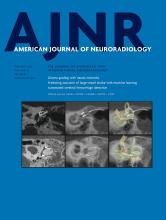Research ArticleAdult Brain
Prediction of Clinical Outcome in Patients with Large-Vessel Acute Ischemic Stroke: Performance of Machine Learning versus SPAN-100
B. Jiang, G. Zhu, Y. Xie, J.J. Heit, H. Chen, Y. Li, V. Ding, A. Eskandari, P. Michel, G. Zaharchuk and M. Wintermark
American Journal of Neuroradiology February 2021, 42 (2) 240-246; DOI: https://doi.org/10.3174/ajnr.A6918
B. Jiang
aFrom the Department of Radiology, Neuroradiology Section (B.J., G.Z., Y.X., J.J.H., H.C., Y.L., G.Z., M.W.), Stanford University School of Medicine, Palo Alto, California
G. Zhu
aFrom the Department of Radiology, Neuroradiology Section (B.J., G.Z., Y.X., J.J.H., H.C., Y.L., G.Z., M.W.), Stanford University School of Medicine, Palo Alto, California
Y. Xie
aFrom the Department of Radiology, Neuroradiology Section (B.J., G.Z., Y.X., J.J.H., H.C., Y.L., G.Z., M.W.), Stanford University School of Medicine, Palo Alto, California
J.J. Heit
aFrom the Department of Radiology, Neuroradiology Section (B.J., G.Z., Y.X., J.J.H., H.C., Y.L., G.Z., M.W.), Stanford University School of Medicine, Palo Alto, California
H. Chen
aFrom the Department of Radiology, Neuroradiology Section (B.J., G.Z., Y.X., J.J.H., H.C., Y.L., G.Z., M.W.), Stanford University School of Medicine, Palo Alto, California
Y. Li
aFrom the Department of Radiology, Neuroradiology Section (B.J., G.Z., Y.X., J.J.H., H.C., Y.L., G.Z., M.W.), Stanford University School of Medicine, Palo Alto, California
V. Ding
bDepartment of Medicine (V.D.), Quantitative Sciences Unit, Stanford University, Stanford, California
A. Eskandari
cNeurology Service (A.E., P.M.), Centre Hospitalier Universitaire Vaudois and Lausanne University, Lausanne, Switzerland
P. Michel
cNeurology Service (A.E., P.M.), Centre Hospitalier Universitaire Vaudois and Lausanne University, Lausanne, Switzerland
G. Zaharchuk
aFrom the Department of Radiology, Neuroradiology Section (B.J., G.Z., Y.X., J.J.H., H.C., Y.L., G.Z., M.W.), Stanford University School of Medicine, Palo Alto, California
M. Wintermark
aFrom the Department of Radiology, Neuroradiology Section (B.J., G.Z., Y.X., J.J.H., H.C., Y.L., G.Z., M.W.), Stanford University School of Medicine, Palo Alto, California

References
- 1.↵
- Benjamin EJ,
- Muntner P,
- Alonso A, et al
- 2.↵
- 3.↵
- 4.↵
- 5.↵
- Turc G,
- Apoil M,
- Naggara O, et al
- 6.↵
- Strbian D,
- Seiffge DJ,
- Breuer L, et al
- 7.↵
- Cooray C,
- Mazya M,
- Bottai M, et al
- 8.↵
- 9.↵
- Saposnik G,
- Guzik AK,
- Reeves M, et al
- 10.↵
- Rangaraju S,
- Aghaebrahim A,
- Streib C, et al
- 11.↵
- Flint AC,
- Faigeles BS,
- Cullen SP, et al
- 12.↵
- Sarraj A,
- Albright K,
- Barreto AD, et al
- 13.↵
- 14.↵
- Hakimelahi R,
- Vachha BA,
- Copen WA, et al
- 15.↵
- 16.↵
- 17.↵
- 18.↵
- 19.↵
- 20.↵
- 21.↵
- Adams HP Jr.,
- Bendixen BH,
- Kappelle LJ, et al
- 22.↵
- Wintermark M,
- Flanders AE,
- Velthuis B, et al
- 23.↵
- 24.↵
- Tan JC,
- Dillon WP,
- Liu S, et al
- 25.↵
- Puetz V,
- Dzialowski I,
- Hill MD, et al
- 26.↵
- Freund Y
- 27.↵
- Chen T,
- Guestrin C
- 28.↵
- 29.↵
- Livne M,
- Boldsen JK,
- Mikkelsen IK, et al
- 30.↵
- DeLong ER,
- DeLong DM,
- Clarke-Pearson DL
- 31.↵
- 32.↵The R Core Team. A Language and Environment for Statistical Computing. R Foundation for Statistical Computing; 1999–2012
- 33.↵
- 34.↵
- 35.↵
- 36.↵
- Adams HP Jr.,
- Davis PH,
- Leira EC, et al
- 37.↵
- Hankey GJ,
- Spiesser J,
- Hakimi Z, et al
- 38.↵
- Weir CJ,
- Murray GD,
- Dyker AG, et al
- 39.↵
- Parsons MW,
- Barber PA,
- Desmond PM, et al
- 40.↵
- Tan IY,
- Demchuk AM,
- Hopyan J, et al
- 41.↵
- Quinn TJ,
- Singh S,
- Lees KR, et al
In this issue
American Journal of Neuroradiology
Vol. 42, Issue 2
1 Feb 2021
Advertisement
B. Jiang, G. Zhu, Y. Xie, J.J. Heit, H. Chen, Y. Li, V. Ding, A. Eskandari, P. Michel, G. Zaharchuk, M. Wintermark
Prediction of Clinical Outcome in Patients with Large-Vessel Acute Ischemic Stroke: Performance of Machine Learning versus SPAN-100
American Journal of Neuroradiology Feb 2021, 42 (2) 240-246; DOI: 10.3174/ajnr.A6918
0 Responses
Prediction of Clinical Outcome in Patients with Large-Vessel Acute Ischemic Stroke: Performance of Machine Learning versus SPAN-100
B. Jiang, G. Zhu, Y. Xie, J.J. Heit, H. Chen, Y. Li, V. Ding, A. Eskandari, P. Michel, G. Zaharchuk, M. Wintermark
American Journal of Neuroradiology Feb 2021, 42 (2) 240-246; DOI: 10.3174/ajnr.A6918
Jump to section
Related Articles
Cited By...
- Development and validation of machine learning-based model for mortality prediction in patients with acute basilar artery occlusion receiving endovascular treatment: multicentric cohort analysis
- Excellence is a habit: Enhancing predictions of language impairment by identifying stable features in clinical perfusion scans
- Preprocedural determination of an occlusion pathomechanism in endovascular treatment of acute stroke: a machine learning-based decision
- End to end stroke triage using cerebrovascular morphology and machine learning
- Machine learning and acute stroke imaging
This article has not yet been cited by articles in journals that are participating in Crossref Cited-by Linking.
More in this TOC Section
Adult Brain
Similar Articles
Advertisement











